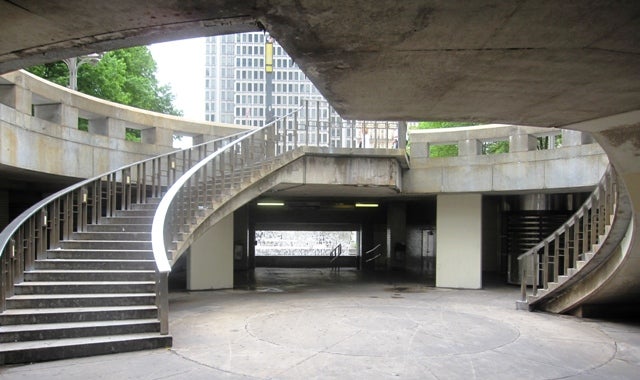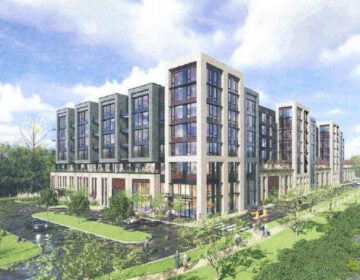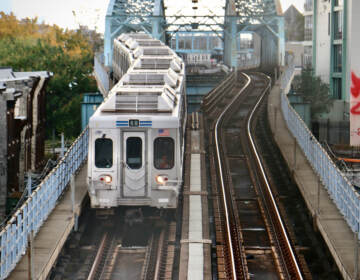Bringing netherworld to life

Planning Commission Director Alan Greenberger leads PlanPhilly on an eye-opening walking tour of the transit concourses beneath Center City.
As if there’s not enough work to do at ground level, City Planning Commission Executive Director Alan Greenberger also has subterranean Philadelphia on his mind.
Earlier this spring, Greenberger took PlanPhilly on an underground tour that trekked from the bustling retail and restaurant space beneath Comcast Center at Arch and 18th Streets through much darker, sparser, dingier corridors to the mixed retail at The Gallery and the rather fancy, light-filled atrium space at the Lit Brothers building, at 7th and Market Streets, where a piano player entertained the lunch crowd.
Greenberger Underground Tour, Part I
Some of the retail space hums, some barely whispers. Some of the connecting hallways, lined with tile or glass or shiny aluminum that sort of says “diner,” are filled with people. Others connectors are less traveled, and some are less-than-welcoming. A few spots are downright creepy.
Greenberger would like all the spaces to be lively and safe feeling and useful. And the city is working in partnership with SEPTA, the Center City District and in some cases private property owners to make this happen. But no one wants the underground to thrive at the expense of the street life, he said, so the process is essentially a balancing act.
“You can make a fair argument that says the more people we put underground, or up on the second level, the fewer of them are on the street,” Greenberger said. “And that’s a dilemma that we have to settle.”
In some cases, the problems seem to hinge on the relative secrecy (except for the sound) by which the trains roll beneath the streets. More residents – and especially visitors – would use the subway and rail system if they knew where to get on board, he said.
“We have two of largest transit hubs in the United States and they are virtually invisible,” Greenberger said. “The one on Market East, you could stand on Market Street and not even know it’s down there at all.”
As the tour begins, Greenberger notes that the proposed American Commerce Center – which would be Philadelphia’s largest skyscraper – would extend the concourse a block further west, to 19th and Arch Streets. The building would likely have “thousands” of people working in it, Greenberger said. “The reason American Commerce was credible to us as a fairly dense development was because of this concourse,” he said. It works “because it’s hooked up to the regional rail system, as well as the city transit system.” In other words, it’s Transit Oriented Development.
These hubs where regional and city transit come together are “very powerful” Greenberger said, and the city has three: 30th Street Station, Suburban Station, and Market East. Each hub is busy and supports retail that is fairly successful, at least on the concourse level.
It’s the byways between the hubs that vary widely. Greenberger has himself used these underground connections to stay dry on a rainy day. But as convenient as that is, Philadelphia isn’t St. Paul. Greenberger wouldn’t advocate building the connected passages today. “This is not a climate where we need to put everybody inside, but, we have it, and we’d be foolish to ignore it,” he said. “And so we need to make it as good as we can, and we need to make its connections to the street as powerful as we can so that there’s a better interchange and flow between the two. That’s how we’re going to win on both fronts.”
The makeover at Dilworth
Past the Suburban Station shops and buskers, and the Post Office branch and SEPTA offices, we emerged into a circle of light beneath Dilworth Plaza at City Hall.
“Now we’re going to transition to the part where it’s all about the transit interconnections – there’s no more retail,” Greenberger said. “This is where it gets a little sketchy.”
Subway riders can exit from either the Market-Frankford or Broad Street lines and take the stairs up through the open well to Dilworth Plaza and City Hall. But on the return trip, they cannot enter the same way. “This isn’t working well yet, and this is why I think the plan for redoing Dilworth Plaza is important to make this have life,” Greenberger said.
The $1.3 million plan on paper he’s talking about has been put together by the Center City District, with $70,000 from adjacent property owners and the remainder from foundation grants. Greenberger and others are enthusiastic (see attached documents below) and the working plan has been critiqued by some members of Philadelphia’s design community.
• Commentary: Get the Plaza right
• City Hall faces fixing its own neighborhood
• DAG position on Dilworth Plaza redo
Center City District Executive Director Paul Levy says the form of the topside public park planned for Dilworth follows the function of what lies underground. “City Hall is at the very center of the city, and every rail system in the city converges there, we want to highlight that,” said Levy. “Most of the public discussion has been on the (CCD plans for) the surface. But so much of what determines the surface is the huge rail structure beneath it.”
A key element would be a new space from which all the transit lines – Market-Frankford (blue) Broad Street (orange) and Subway Surface (green) – could be accessed, Levy said. There would also be a token booth there.
Plans for the plaza itself include a cafe, green space, and a programmable fountain that can be turned off to create space for farmers’ markets, concerts, and other events. The plans to make this happen were presented to the Planning Commission at an informational meeting and have been “extensively reviewed with Alan Greenberger, (deputy mayor) Rina Cutler, the commissioner of public property, the city representative, SEPTA and the Streets Department,” said CCD spokesman RJ White. “We’ve also received a favorable recommendation from the architectural review committee of the Historical Commission and formal approval from the Historical Commission of the schematic design.”
CCD plans to take the proposal to the Art Commission this fall. Other approvals – including a formal blessing from the Planning Commission, are also needed. So is money. About $1.3 million for the planning stage was raised through grants from foundations and donations from adjacent businesses. Construction will cost about $45 million, money which is expected to come from state and federal government, local foundations, private grants and, potentially, a CCD bond issue.
Greenberger leads the way past the Dilworth Plaza area underground through a tiled hallway. “This is City Hall Station. So it’s our central station in Philadelphia, right under City Hall. And yet it’s all very complicated, and very dark, and not very generous feeling.”
SEPTA will renovate City Hall Station and partially renovate the 15th Street Station whether or not CCD gets the money and approvals it needs for the topside of Dilworth Plaza. But Heiser said that more work will be done – and the station will get more use – with the Dilworth Plaza renovation.
“City Hall Station is for the most part a transfer station,” Heiser said. On school day afternoons, for example, many students transfer between the Broad Street and Market-Frankford lines, he said. “What the Center City District is proposing will make it much more of a destination. And that’s a good thing. People will come to the plaza just for enjoyment, entertainment or other activities, and some people may chose to use public transit to get there.”
SEPTA’s work on the City Hall Station will result in something that looks brand new and works in a very different, better way, Heiser said. Elevators from the surface to all station levels will make the trains more accessible. Three, 30-foot sections of four-foot thick pier walls will be removed and replaced with a girder, which will take over the job of supporting the huge beams that hold up the foundation of City Hall. It will take a lot of planning and engineering to do this – temporary underpinning is necessary. But the end result will be a much more open, roomier, brighter space, Heiser said.
SEPTA also plans to improve two corridors. The one that links City Hall and 15th Street Station is old and has some turns in it that hamper visibility. It will be closed and replaced with a new, wider straight connection. People will be able to see from one end to the other, and that improves safety, Heiser said. Similarly, an existing connection on the east end of the South Mezzanine will be widened.
The station at 15th Street will also be partially renovated to bring it up to Americans with Disabilities Act standards.
None of this will come cheaply or quickly, however. SEPTA had originally started this project in 1999. A design consultant was hired, and about 15 percent of the design work was completed. The project has been in suspension since 2005, but design work on the Dilworth Plaza area will resume this fall, with 15th Street Station and City Hall Station design work expected to begin several months later. Construction on Dilworth Plaza and City Hall Station would start in early 2011. Because the City Hall station work is complicated, it would likely take about two and a half years to design. Work would begin in early 2014, Heiser said, and would take at least 3.5 years to build.
Project cost: Upwards of $100 million.
It’s all about access
Dilworth Plaza isn’t the only spot where CCD hopes to boost transit visibility. There are 108 subway entrances to either SEPTA or PATCO trains within the Center City District. This September, new signs will start going up at 35 of them. A street-level icon with either the SEPTA or PATCO logo will alert pedestrians that transit lurks beneath them. At the bottom of the stairs will be an orientation map to help transit riders use the trains. Paid for with a $375,000 grant from the William Penn Foundation, a $10,000 grant from the Delaware River Port Authority and $312,500 from SEPTA, the signs have already been installed at a few test sites, including the corner of 18th Street and JFK Boulevard and the southwest corner of Broad and Walnut Streets.
Levy points out that in New York City, the type of transit ridership with the most growth has been the discretionary riders category – tourists and local people who are off to the theater, a museum, a sporting event or dinner. Making SEPTA easier to find and understand could encourage that kind of ridership here, too, he said.
Back on the Greenberger tour, we head from the City Hall subway station down a long, tiled passage. Greenberger says he’s been down here at night, and it looks exactly the same: Not many people are there any time of day. There probably isn’t much that can be done – or needs to be done – in a passage like this, he said. The important thing is to improve both ends so that there’s safe, useful and interesting places to get to and from. More people help make a place feel safer, he said.
We reach 13th Street Station, and Greenberger points out the connection to 1234 Market Street – the home of SEPTA’s headquarters. When Greenberger worked at the PSFS building in the 1980s, “there used to be an absolutely magnificent connection” that he would use after taking the subway to the 12th Street Station from West Philadelphia.
Many more buildings had underground links to the city subway system, but they started to close in the 1960s and ’70s. “More people were living in the suburbs and commuting with Regional Rail,” Greenberger said. “There were not enough people, there were difficult security arrangements, so they just decided that the safer, better thing to do was simply not to have them, and they shut them down.”
Would Greenberger like to see some of these portals re-opened? “I think it would be great. I mean, there has to be enough life and reason to. But it would be great if there was access again, at least in some strategic locations,” he said.
Current trends, including rising fuel prices, the desire of more people to reduce their time in cars, and transit-oriented development could help bring that life to some areas, Greenberger said. “If there is more foot traffic, there would be retail or some other uses to serve that traffic,” he said. “Our job is to take advantage of it, but also make sure that it all connects to grade nicely and gets people outside.”
We walk down a long passageway of tile and glass block from the 13th Street Station to 11th Street station. Through the glass block are basements that, should there ever be the need, could also be opened into the corridor.
Life in The Gallery
The passageway ends, and we turn to the left, to the edge of The Gallery, and the banks of monitors displaying train departure times that marks the entrance to the Market Street Station.
The Gallery is lunch-time busy, and people are also heading into the station. Just beyond the station is the bus terminal, and more people, Greenberger notes. But we are standing in a big, empty space.
“One of the things we’re looking at in our Market East Plan is how to make this all livelier,” Greenberger said. “There’s no retail strategy down here, and as it goes up into the Head House of the Reading Terminal, which is the Pennsylvania Convention Center entrance, there’s not much going on.”
The whole area needs “a better retailing strategy” and that is one of the things that Stan Eckstut, the founding principal of New York’s Ehrenkrantz Eckstut & Kuhn Architects, is working on as part of the master plan for Market East.
The Head House portion of the building is actually owned by a city agency – the Redevelopment Authority. It helps to have that section in the public domain, Greenberger said.
Walking into the shops and restaurants of The Gallery, Greenberger calls it a great space, but notes that “it gets harder and harder as you go up to lease this space.” The concourse and first level get a lot of foot traffic, he explained, but that dwindles on upper levels.
Linking these various transportation modes is also a topic to be addressed by the Market East master plan.
“One of things were looking at is how to make a proper interstate bus situation … and then linking it across into The Gallery,” Greenberger said. The link might be a bridge that would bring bus riders into those upper Gallery floors. Although it’s not evident from Market Street, The Gallery functions as the lobby for Market Street Station, he said. “We’d like this thing to also function that way for interstate bus traffic, which is becoming more popular and better all the time.”
Greenberger said that Philadelphia already has all the stuff that’s difficult and expensive to create. “The rail is already built. The big, wonderful public space, the retail that supports it – it’s all here. What’s not here are the last of the connections.”
Greenberger says more needs to be done to give what is now under ground a concrete presence on the street, and the Master Plan will address that, too. But there are mitigating factors at times. The corner of 8th and Market Streets is an empty site, so why would anyone want to be there, he asked. When Gimbels was there, the street had life.
Center City District’s Levy agrees with Greenberger that getting more people – even non-transit users – below ground would be a good thing. But he’s not interested in uses that would duplicate what can be found above ground and dilute the potential customer base.
CCD has taken a very preliminary look at what could be done with the under-utilized spaces in a way that would not hurt retail shops and restaurants above ground.
Levy said he’s not ready to share the preliminary study of potential underground uses for the South Broad Street area. It’s too early, and at this point, nothing is on the horizon. But Levy offered some examples: The South Broad concourse has wide columns and more open space than is needed, he said. Could some space along the walls be used as a place to store bicycles? Or could it be used for a bicycle repair shop? Another idea: an artist studio, or classroom space for pottery or painting classes at the University of the Arts. But before anyone gets too excited, Levy says there are a lot of train-related realities that would have to be explored. Could any class be held when a train goes by every four minutes, for example. Would vibrations knock artwork to the floor?
Levy uses the words “balancing act,” too. The Gallery isn’t the only place where one can see the corollary between a vibrant underground and a lack of activity on the street level above, he said. Most of the street level retail around Penn Center is heavy on banking, he said. “There’s a direct connection from the building into the underground, without going outside,” he said. “It’s a great convenience, but there is an effect on street level retail.”
Philadelphia does not have the population density of Tokyo, which can support vibrant retail both above and below ground, he said. Montreal, with its long periods of cold weather, has most of its vibrant retail underground, but it does not have much going on top-side, he said.
Greenberger has also compared Philly to other cities. He thinks we are big enough and robust enough to support retail both above and below grade. “The answer is not a startling yes – this isn’t New York City – but it’s close enough to yes that we ought to be able to make this work,” he said.
During the tour, The Gallery ends and the basement of the former Strawbridge & Clothier site, with its display windows, comes into view. The main entrance on this level is still in use. Foxwoods Casino hopes to open inside, and that would “probably introduce more life into this concourse.” The plan has opposition, and Foxwoods has yet to formally request a license address change from its South Philadelphia riverfront location to this site.
Past Strawbridge’s is another point with a lot of transit modes in close proximity: The Market-Frankford Line’s 8th Street Station, and connections to New Jersey’s PATCO system and the Broad-Ridge Spur that runs from Fern Rock in North Philadelphia down Broad Street to Ridge Avenue before veering off and ending at this spot.
The tour ends at the Lit Brothers building, which Greenberger said is a good example of a building that takes advantage of its lower level transit connection with retail, a fresh fruit market, a pizzeria and eateries – yet also connects to the street.
Tiny lights twinkle on the ceiling, until it opens up into an atrium filled with natural light. A piano player performs in the seating area. He notes the natural light and escalators. “You know how to get out, and not everybody is staying down here,” he said.
We hop on the escalator and emerge on the street near the corner of 7th and Market Streets, having traveled 11 blocks underground.
Greenberger almost immediately begins pointing out underperforming sections of Market Street East, ground level.
“We have to find a way to enliven all of this,” he said. Greenberger said he also thinks most of the elements for a lively Market Street are in place. It’s just that many of them have no presence on Market Street.
“We look around, look to either side of Market Street, to Chinatown, to Thomas Jefferson Hospital, to Wash West, the great transit hub – which is really on Filbert Street – we look at all these things and we say, they’re all there,” he said. “All that energy and life is there, but they have no Market Street presence. So one of the things we’re looking at … is just to figure out a way to bring them to here, to try and get them to Market Street.”
Anyone interested can learn more about the city’s hopes and plans for Market Street East – both above and under ground – on Tuesday, June 23, when a draft of the proposed Market Street East Master Plan will be discussed at a 6:30 p.m. public meeting at the Center for Architecture, 1216 Arch Street.
Interested in an underground tour? The Preservation Alliance of Greater Philadelphia has one scheduled for 10 a.m. this Saturday, June 20. Cost is $10 for adults, $5 for members, $8 for students, and free for kids under 10 accompanied by an adult, plus one SEPTA fare. For more information, click here. Scroll down to the June 20 events.
Contact the reporter at kelliespatrick@gmail.com

Dilworth Plaza report:
http://www.centercityphila.org/docs/CCRDilworthPlaza2009.pdf
WHYY is your source for fact-based, in-depth journalism and information. As a nonprofit organization, we rely on financial support from readers like you. Please give today.






